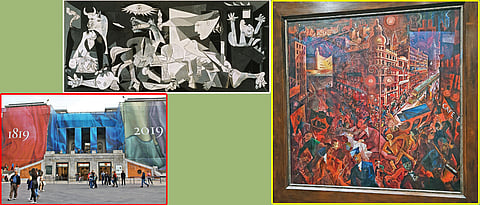

Pintura Espanola,” I read out aloud from the brochure. The 20-odd strangers around take no notice of me, as they are immersed in appreciating ‘Las Meninas’ — a 1656 artwork by Spanish painter Diego Velázquez — a painting which places the spectator as a participant in the story unfolding on the canvas. I am in Museo Nacional del Prado, a museum situated in the heart of Madrid in Spain. This neo-classical building shelters one of the finest collections of European art in the world — my first stop in the golden triangle of art itinerary.
Under the patronage of Fernando VII, in 1819, the museum was opened to the public, sourcing its first ever collection of artwork from the various royal residences. The collections of Museo del Prado spans over the 12th to 19th century with a rich repository of Spanish, Italian, German, Flemish, Dutch and French paintings, and sculptures by Renaissance and Baroque artists like Maíno, Caravaggio, Poussin, Rembrandt, Raphael and many more.
The exhibits are categorised by the country of origin of the painters. On the first floor, from within a golden frame hung on the wall, a mustachioed gentleman dressed in a black gown with white ruff arrested me in his gaze — ‘The Nobleman with his hand on his chest’ is a famous work of El Greco, a Greek painter of the Spanish Renaissance.
Upstairs, art aficionados scrutinise the warm hues and circular brush-strokes imparting sensuality in the painting of the three nude women, set in a Greek mythological universe — ‘The Three Graces’ — a masterpiece by Flemish painter Peter Paul Rubens. Spread across seven rooms are the works of late 18th century’s Spanish artist Francisco Goya. Many of his highly emotive artworks capture the gory reality and uncertainties of the Peninsular War (1808 - 1814), of which ‘The 3rd of May, 1808 in Madrid’, where the fleeting moment of distress in the expressive faces of the Madrileños held at rifle-point leaves a deep imprint on my mind.
As I unwillingly leave the premises of Prado, walking out of the ground floor populated with paintings by Fra Angelico, Rafael, Tintoretto, Titian, Bosch, and many more, calm faces, typical of Renaissance period, stare at me.
The sunrays are tangential. On the boulevard of Paseo del Prado, the trees have just started to turn yellow. As I walk, a crisp chill caresses me. Fifteen minutes later, I arrive at Museo Nacional Centro de Arte Reina Sofía, a complement of Prado. At Reina Sofia, art is subjective, liberating.
Reina Sofia has a collection of 21,000 artworks ranging from Spanish paintings, sculptures, drawings, prints, photographs, installations, videos, decorative arts and architectural works spanning over late 19th century, to the present day. The museum itinerary highlights approximately 1000 artworks, a mere five per cent of the total collection. The exhibits are not classified by artists but arranged in a non-linear form to construct mini-narratives that helps a viewer in understanding the meaning.
I walk along the first collection, ‘The Irruption of the 20th Century: Utopias and Conflicts (1900 - 1945)’. This was the era of World Wars and the Holocaust. On the canvas of the painters, the tremendous evils brewing in the society whip up sharp emotions, art is no more objective. Details and pictorial depictions of reality are replaced with expressions. Avant Garde, Cubism, Surrealism and Dadaism artworks by modern Spanish artists Salvador Dalí, Joan Miró, Antoni Tàpies, Richard Serra and many more find a space here.
On a black and grey canvas, screaming women, injured people and animals are placed chaotically within a frame — a sight of anarchy. In room 206.06 is the most famous painting of the museum, ‘Guernica’, by Spanish painter Pablo Picasso. The evils of bombing of the Basque town of Guernica in Spain by the Nazi Germany have been the driving forces behind the painting.
The other two trails of permanent collections in the museum focus on the Cold War, increasing consumerism, polarization of East and West and finally the world of 1960s-1980s — a time which saw decolonisation, feminist movements and economic struggles. As I exit the museum, I realise the quest of art has moved inwards to the seeker’s soul.
I come back to this boulevard the next day, for my final stop on the art itinerary, Thyssen-Bornemisza Museo Nacional. Originally, a private collection by the wealthy Thyssen-Bornemisza family, this museum was acquired by the Spanish Government in 1993. Museo Thyssen brings together the objective and subjective of art world. Having almost 1000 paintings, extending from the 13th to 20th centuries, the collection records all the art movements of the Western world during that time.
Masterpieces of by Domenico Ghirlandaio, Albrecht Dürer, Caravaggio, Rubens, Manet, Vincent van Gogh, Paul Gauguin, Paul Cézanne, Franz Marc, Willem de Kooning hang on the saffron walls. Vincent van Gogh’s ‘Les Vessenots in Auvers’, a painting on country life, captures my eye with vivid yellows and greens. In stark contrast, German artist George Grosz’s painting ‘Metropolis’ leaves me numb with haphazard dark strokes portraying the alienation of people in apocalyptic Berlin during World War I.
To say the golden triangle of art in Madrid overwhelmed me would be an understatement.
